Impact of Human Behavior on Plastic Usage and Recycling: A Study
VerifiedAdded on 2022/11/13
|14
|2677
|451
AI Summary
This study explores the impact of human behavior on plastic usage and recycling. It discusses the findings of a structured questionnaire presented to 12 participants and suggests alternatives to plastic use.
Contribute Materials
Your contribution can guide someone’s learning journey. Share your
documents today.
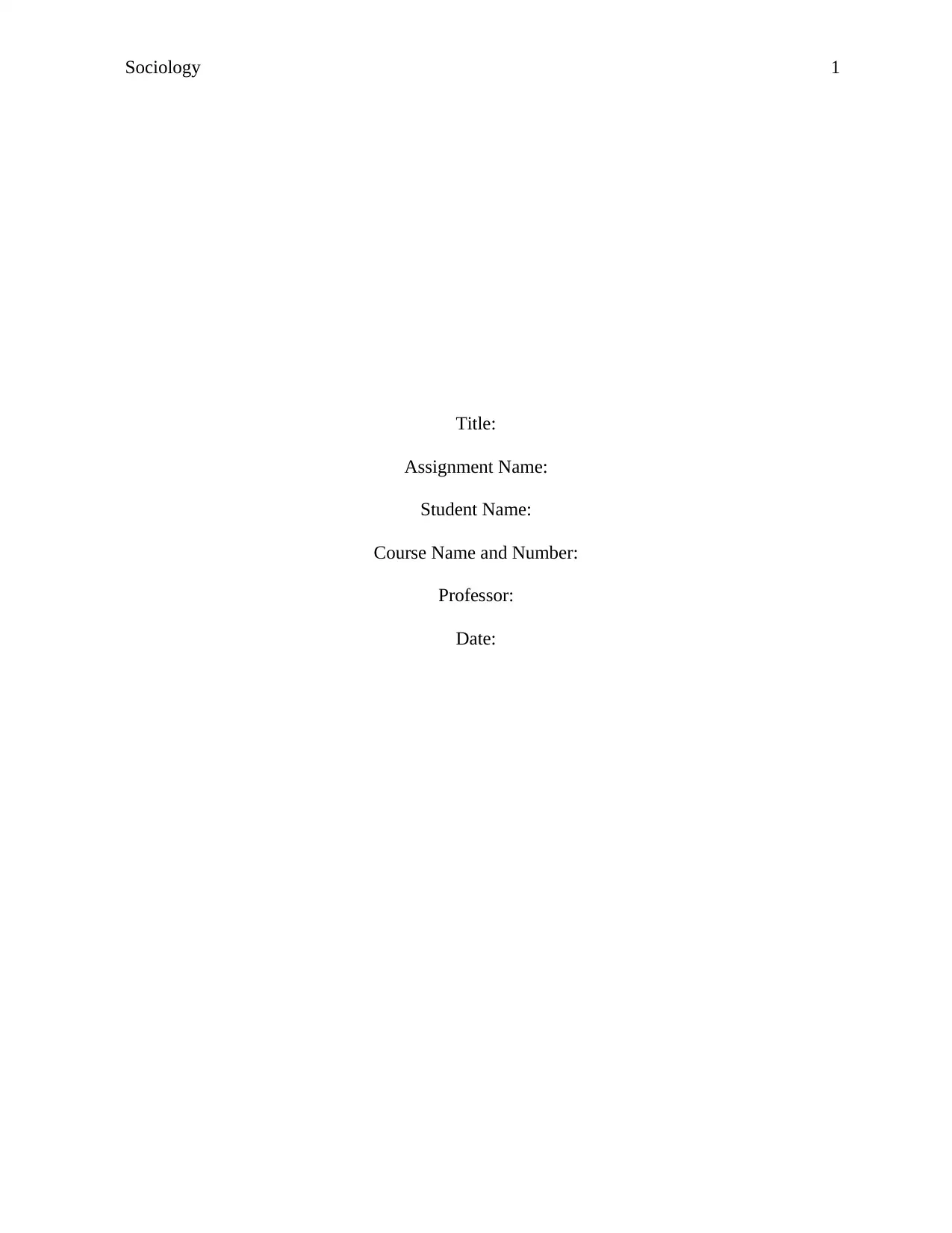
Sociology 1
Title:
Assignment Name:
Student Name:
Course Name and Number:
Professor:
Date:
Title:
Assignment Name:
Student Name:
Course Name and Number:
Professor:
Date:
Secure Best Marks with AI Grader
Need help grading? Try our AI Grader for instant feedback on your assignments.
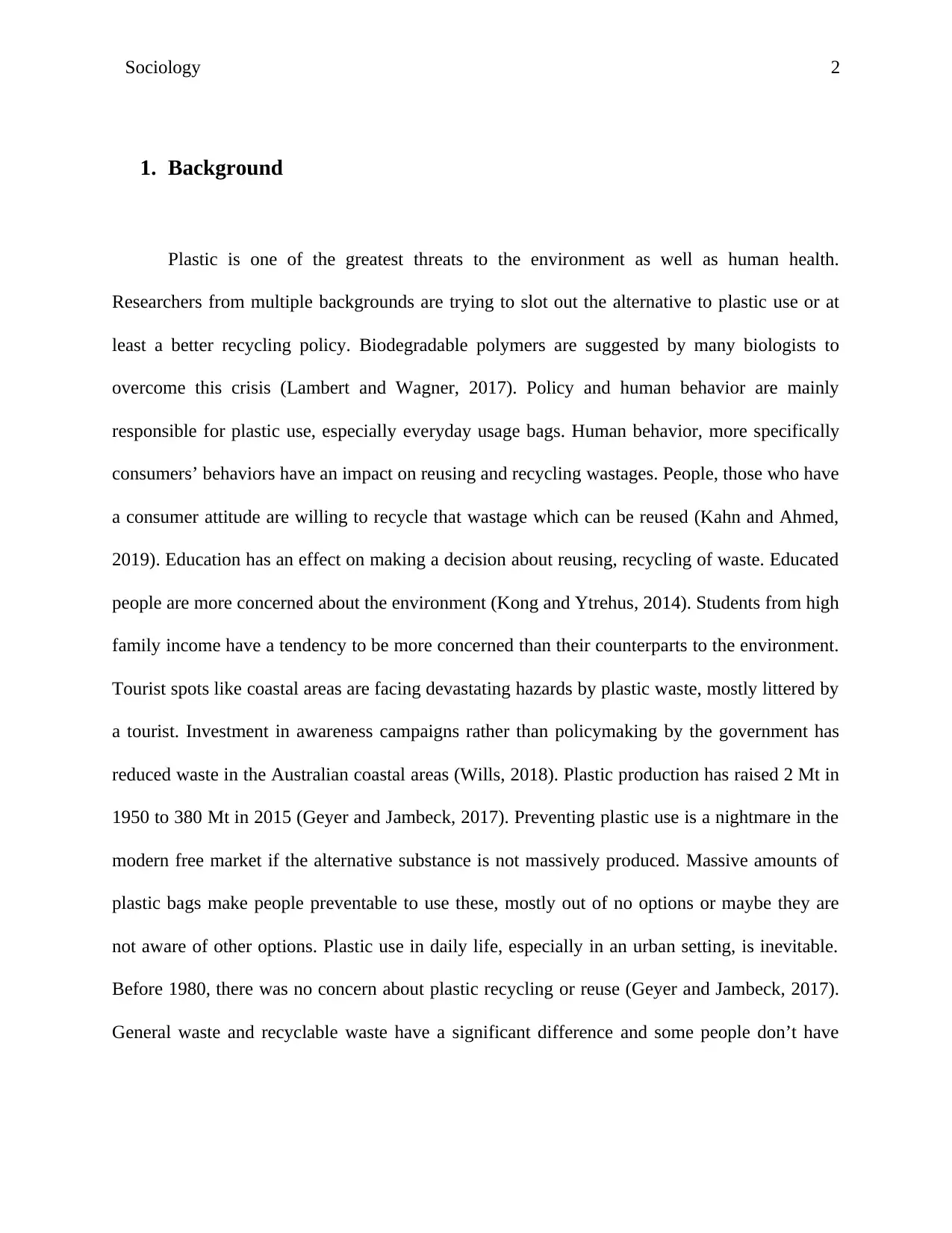
Sociology 2
1. Background
Plastic is one of the greatest threats to the environment as well as human health.
Researchers from multiple backgrounds are trying to slot out the alternative to plastic use or at
least a better recycling policy. Biodegradable polymers are suggested by many biologists to
overcome this crisis (Lambert and Wagner, 2017). Policy and human behavior are mainly
responsible for plastic use, especially everyday usage bags. Human behavior, more specifically
consumers’ behaviors have an impact on reusing and recycling wastages. People, those who have
a consumer attitude are willing to recycle that wastage which can be reused (Kahn and Ahmed,
2019). Education has an effect on making a decision about reusing, recycling of waste. Educated
people are more concerned about the environment (Kong and Ytrehus, 2014). Students from high
family income have a tendency to be more concerned than their counterparts to the environment.
Tourist spots like coastal areas are facing devastating hazards by plastic waste, mostly littered by
a tourist. Investment in awareness campaigns rather than policymaking by the government has
reduced waste in the Australian coastal areas (Wills, 2018). Plastic production has raised 2 Mt in
1950 to 380 Mt in 2015 (Geyer and Jambeck, 2017). Preventing plastic use is a nightmare in the
modern free market if the alternative substance is not massively produced. Massive amounts of
plastic bags make people preventable to use these, mostly out of no options or maybe they are
not aware of other options. Plastic use in daily life, especially in an urban setting, is inevitable.
Before 1980, there was no concern about plastic recycling or reuse (Geyer and Jambeck, 2017).
General waste and recyclable waste have a significant difference and some people don’t have
1. Background
Plastic is one of the greatest threats to the environment as well as human health.
Researchers from multiple backgrounds are trying to slot out the alternative to plastic use or at
least a better recycling policy. Biodegradable polymers are suggested by many biologists to
overcome this crisis (Lambert and Wagner, 2017). Policy and human behavior are mainly
responsible for plastic use, especially everyday usage bags. Human behavior, more specifically
consumers’ behaviors have an impact on reusing and recycling wastages. People, those who have
a consumer attitude are willing to recycle that wastage which can be reused (Kahn and Ahmed,
2019). Education has an effect on making a decision about reusing, recycling of waste. Educated
people are more concerned about the environment (Kong and Ytrehus, 2014). Students from high
family income have a tendency to be more concerned than their counterparts to the environment.
Tourist spots like coastal areas are facing devastating hazards by plastic waste, mostly littered by
a tourist. Investment in awareness campaigns rather than policymaking by the government has
reduced waste in the Australian coastal areas (Wills, 2018). Plastic production has raised 2 Mt in
1950 to 380 Mt in 2015 (Geyer and Jambeck, 2017). Preventing plastic use is a nightmare in the
modern free market if the alternative substance is not massively produced. Massive amounts of
plastic bags make people preventable to use these, mostly out of no options or maybe they are
not aware of other options. Plastic use in daily life, especially in an urban setting, is inevitable.
Before 1980, there was no concern about plastic recycling or reuse (Geyer and Jambeck, 2017).
General waste and recyclable waste have a significant difference and some people don’t have
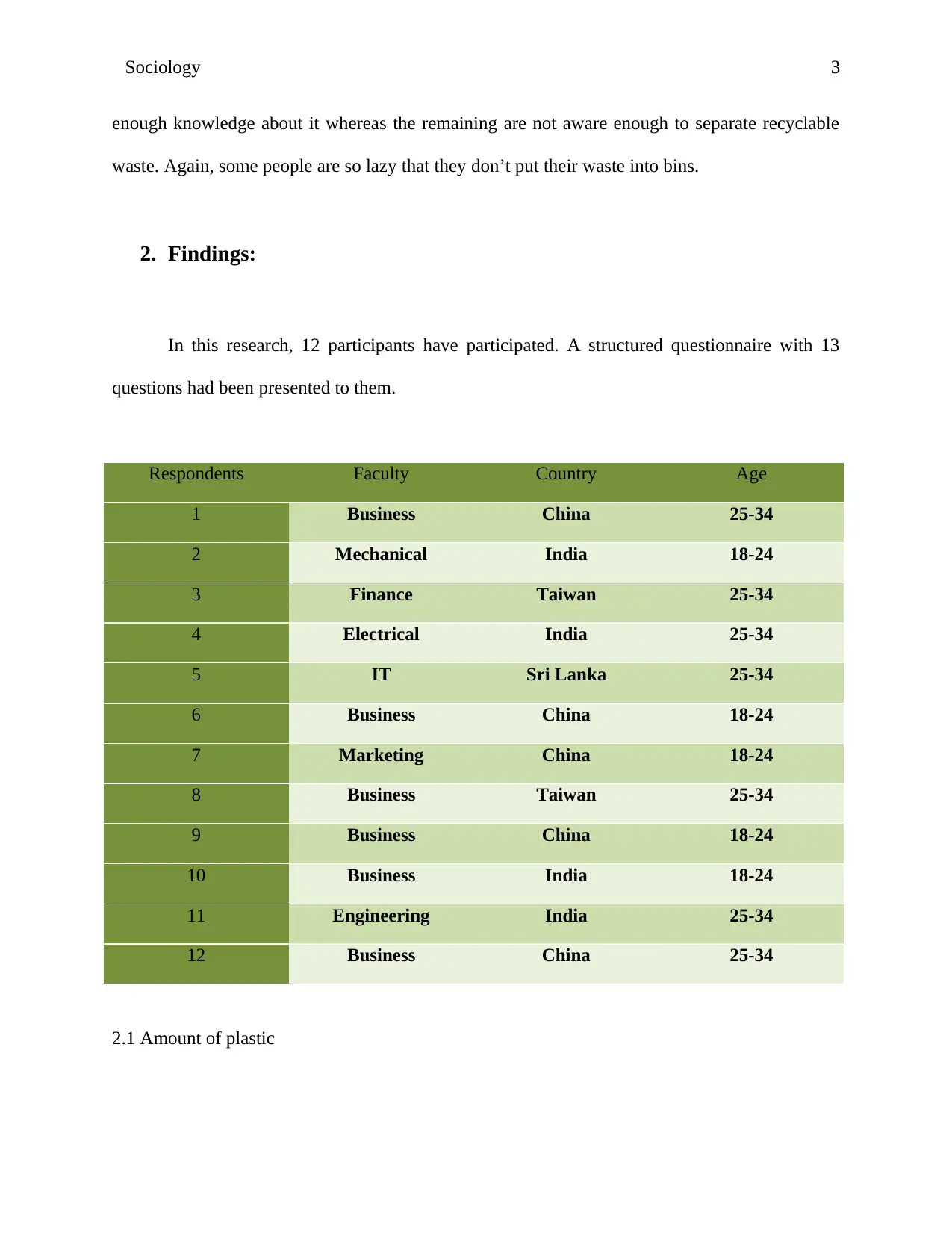
Sociology 3
enough knowledge about it whereas the remaining are not aware enough to separate recyclable
waste. Again, some people are so lazy that they don’t put their waste into bins.
2. Findings:
In this research, 12 participants have participated. A structured questionnaire with 13
questions had been presented to them.
Respondents Faculty Country Age
1 Business China 25-34
2 Mechanical India 18-24
3 Finance Taiwan 25-34
4 Electrical India 25-34
5 IT Sri Lanka 25-34
6 Business China 18-24
7 Marketing China 18-24
8 Business Taiwan 25-34
9 Business China 18-24
10 Business India 18-24
11 Engineering India 25-34
12 Business China 25-34
2.1 Amount of plastic
enough knowledge about it whereas the remaining are not aware enough to separate recyclable
waste. Again, some people are so lazy that they don’t put their waste into bins.
2. Findings:
In this research, 12 participants have participated. A structured questionnaire with 13
questions had been presented to them.
Respondents Faculty Country Age
1 Business China 25-34
2 Mechanical India 18-24
3 Finance Taiwan 25-34
4 Electrical India 25-34
5 IT Sri Lanka 25-34
6 Business China 18-24
7 Marketing China 18-24
8 Business Taiwan 25-34
9 Business China 18-24
10 Business India 18-24
11 Engineering India 25-34
12 Business China 25-34
2.1 Amount of plastic
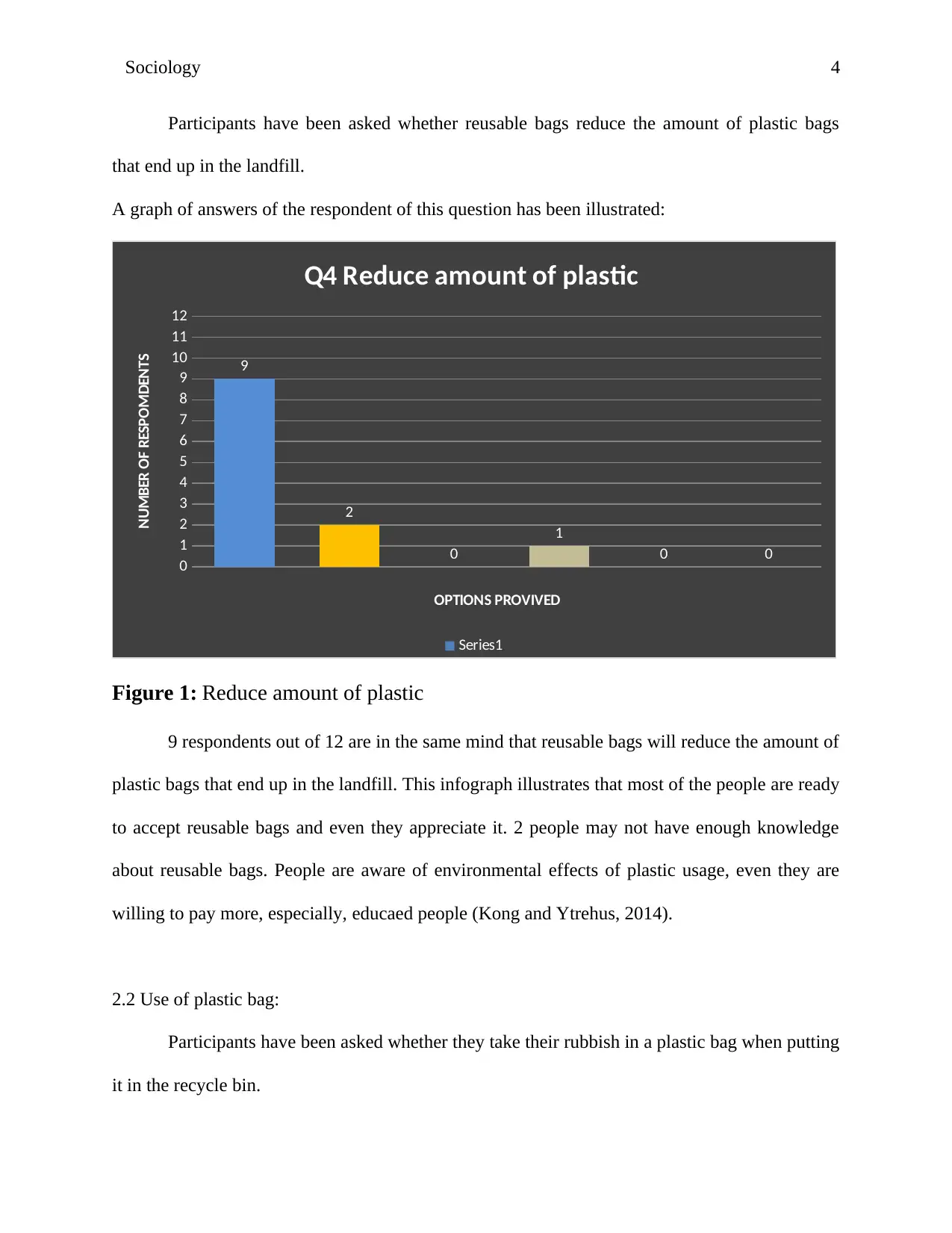
Sociology 4
Participants have been asked whether reusable bags reduce the amount of plastic bags
that end up in the landfill.
A graph of answers of the respondent of this question has been illustrated:
0
1
2
3
4
5
6
7
8
9
10
11
12
9
2
0
1
0 0
Q4 Reduce amount of plastic
Series1
OPTIONS PROVIVED
NUMBER OF RESPOMDENTS
Figure 1: Reduce amount of plastic
9 respondents out of 12 are in the same mind that reusable bags will reduce the amount of
plastic bags that end up in the landfill. This infograph illustrates that most of the people are ready
to accept reusable bags and even they appreciate it. 2 people may not have enough knowledge
about reusable bags. People are aware of environmental effects of plastic usage, even they are
willing to pay more, especially, educaed people (Kong and Ytrehus, 2014).
2.2 Use of plastic bag:
Participants have been asked whether they take their rubbish in a plastic bag when putting
it in the recycle bin.
Participants have been asked whether reusable bags reduce the amount of plastic bags
that end up in the landfill.
A graph of answers of the respondent of this question has been illustrated:
0
1
2
3
4
5
6
7
8
9
10
11
12
9
2
0
1
0 0
Q4 Reduce amount of plastic
Series1
OPTIONS PROVIVED
NUMBER OF RESPOMDENTS
Figure 1: Reduce amount of plastic
9 respondents out of 12 are in the same mind that reusable bags will reduce the amount of
plastic bags that end up in the landfill. This infograph illustrates that most of the people are ready
to accept reusable bags and even they appreciate it. 2 people may not have enough knowledge
about reusable bags. People are aware of environmental effects of plastic usage, even they are
willing to pay more, especially, educaed people (Kong and Ytrehus, 2014).
2.2 Use of plastic bag:
Participants have been asked whether they take their rubbish in a plastic bag when putting
it in the recycle bin.
Secure Best Marks with AI Grader
Need help grading? Try our AI Grader for instant feedback on your assignments.
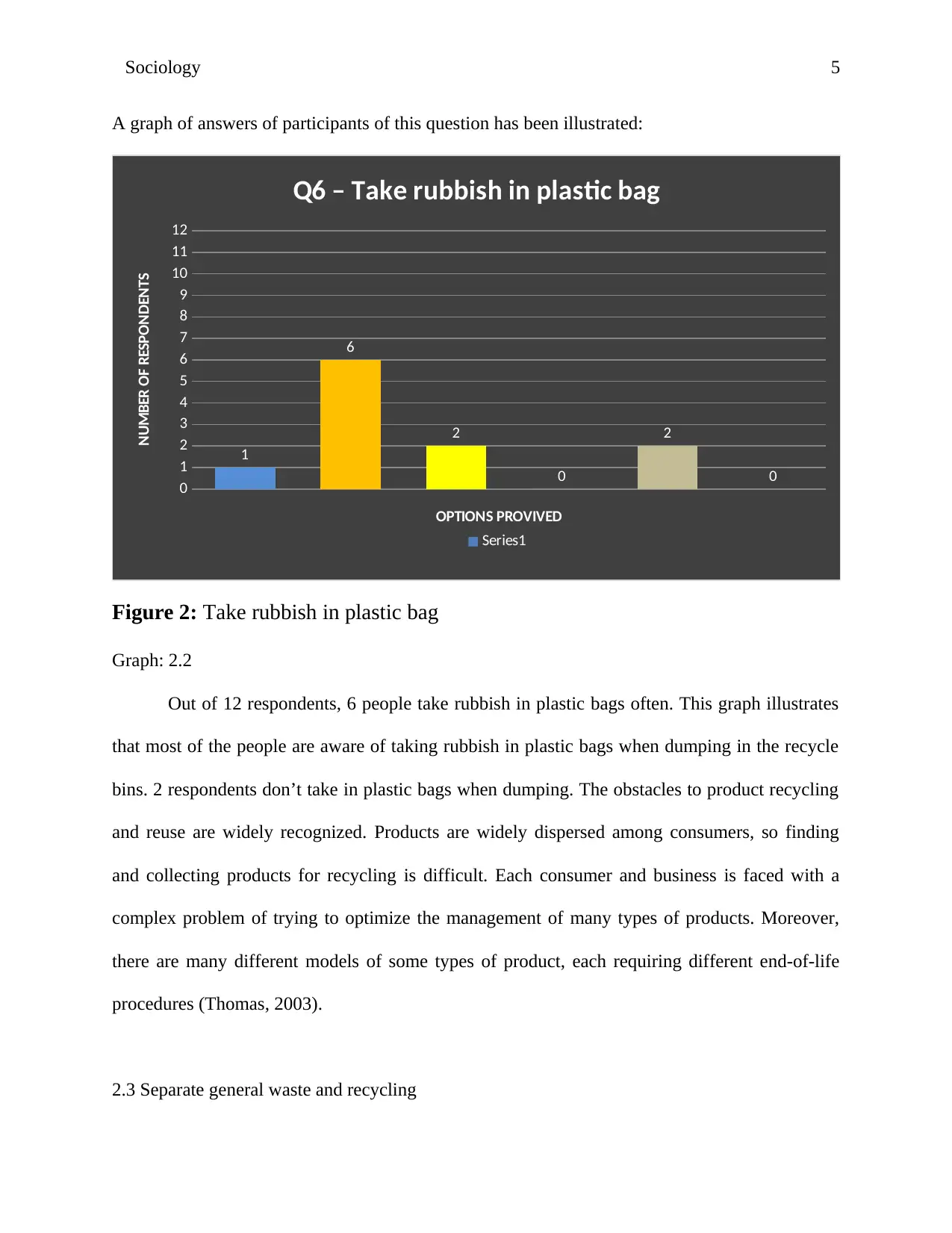
Sociology 5
A graph of answers of participants of this question has been illustrated:
0
1
2
3
4
5
6
7
8
9
10
11
12
1
6
2
0
2
0
Q6 – Take rubbish in plastic bag
Series1
OPTIONS PROVIVED
NUMBER OF RESPONDENTS
Figure 2: Take rubbish in plastic bag
Graph: 2.2
Out of 12 respondents, 6 people take rubbish in plastic bags often. This graph illustrates
that most of the people are aware of taking rubbish in plastic bags when dumping in the recycle
bins. 2 respondents don’t take in plastic bags when dumping. The obstacles to product recycling
and reuse are widely recognized. Products are widely dispersed among consumers, so finding
and collecting products for recycling is difficult. Each consumer and business is faced with a
complex problem of trying to optimize the management of many types of products. Moreover,
there are many different models of some types of product, each requiring different end-of-life
procedures (Thomas, 2003).
2.3 Separate general waste and recycling
A graph of answers of participants of this question has been illustrated:
0
1
2
3
4
5
6
7
8
9
10
11
12
1
6
2
0
2
0
Q6 – Take rubbish in plastic bag
Series1
OPTIONS PROVIVED
NUMBER OF RESPONDENTS
Figure 2: Take rubbish in plastic bag
Graph: 2.2
Out of 12 respondents, 6 people take rubbish in plastic bags often. This graph illustrates
that most of the people are aware of taking rubbish in plastic bags when dumping in the recycle
bins. 2 respondents don’t take in plastic bags when dumping. The obstacles to product recycling
and reuse are widely recognized. Products are widely dispersed among consumers, so finding
and collecting products for recycling is difficult. Each consumer and business is faced with a
complex problem of trying to optimize the management of many types of products. Moreover,
there are many different models of some types of product, each requiring different end-of-life
procedures (Thomas, 2003).
2.3 Separate general waste and recycling
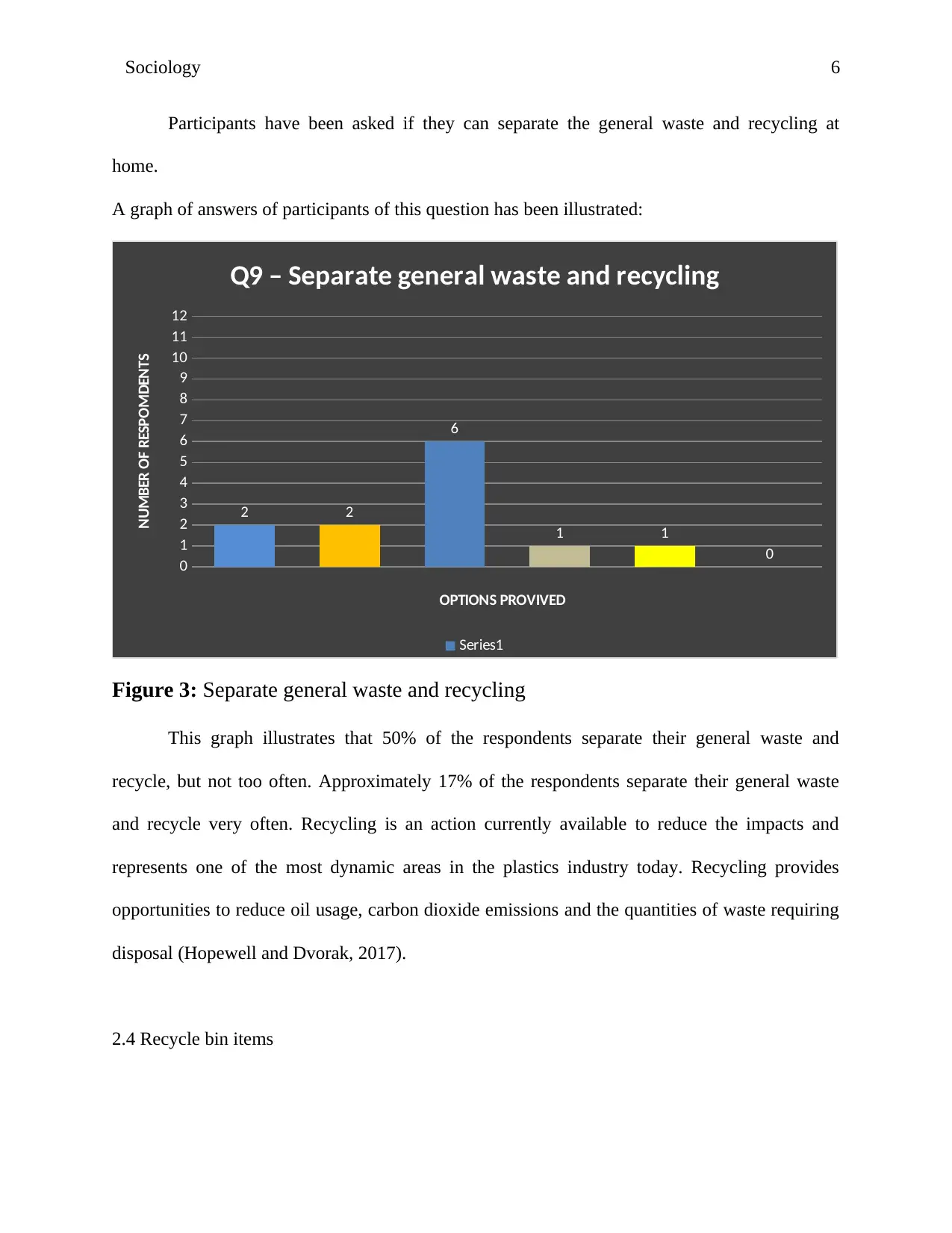
Sociology 6
Participants have been asked if they can separate the general waste and recycling at
home.
A graph of answers of participants of this question has been illustrated:
0
1
2
3
4
5
6
7
8
9
10
11
12
2 2
6
1 1
0
Q9 – Separate general waste and recycling
Series1
OPTIONS PROVIVED
NUMBER OF RESPOMDENTS
Figure 3: Separate general waste and recycling
This graph illustrates that 50% of the respondents separate their general waste and
recycle, but not too often. Approximately 17% of the respondents separate their general waste
and recycle very often. Recycling is an action currently available to reduce the impacts and
represents one of the most dynamic areas in the plastics industry today. Recycling provides
opportunities to reduce oil usage, carbon dioxide emissions and the quantities of waste requiring
disposal (Hopewell and Dvorak, 2017).
2.4 Recycle bin items
Participants have been asked if they can separate the general waste and recycling at
home.
A graph of answers of participants of this question has been illustrated:
0
1
2
3
4
5
6
7
8
9
10
11
12
2 2
6
1 1
0
Q9 – Separate general waste and recycling
Series1
OPTIONS PROVIVED
NUMBER OF RESPOMDENTS
Figure 3: Separate general waste and recycling
This graph illustrates that 50% of the respondents separate their general waste and
recycle, but not too often. Approximately 17% of the respondents separate their general waste
and recycle very often. Recycling is an action currently available to reduce the impacts and
represents one of the most dynamic areas in the plastics industry today. Recycling provides
opportunities to reduce oil usage, carbon dioxide emissions and the quantities of waste requiring
disposal (Hopewell and Dvorak, 2017).
2.4 Recycle bin items
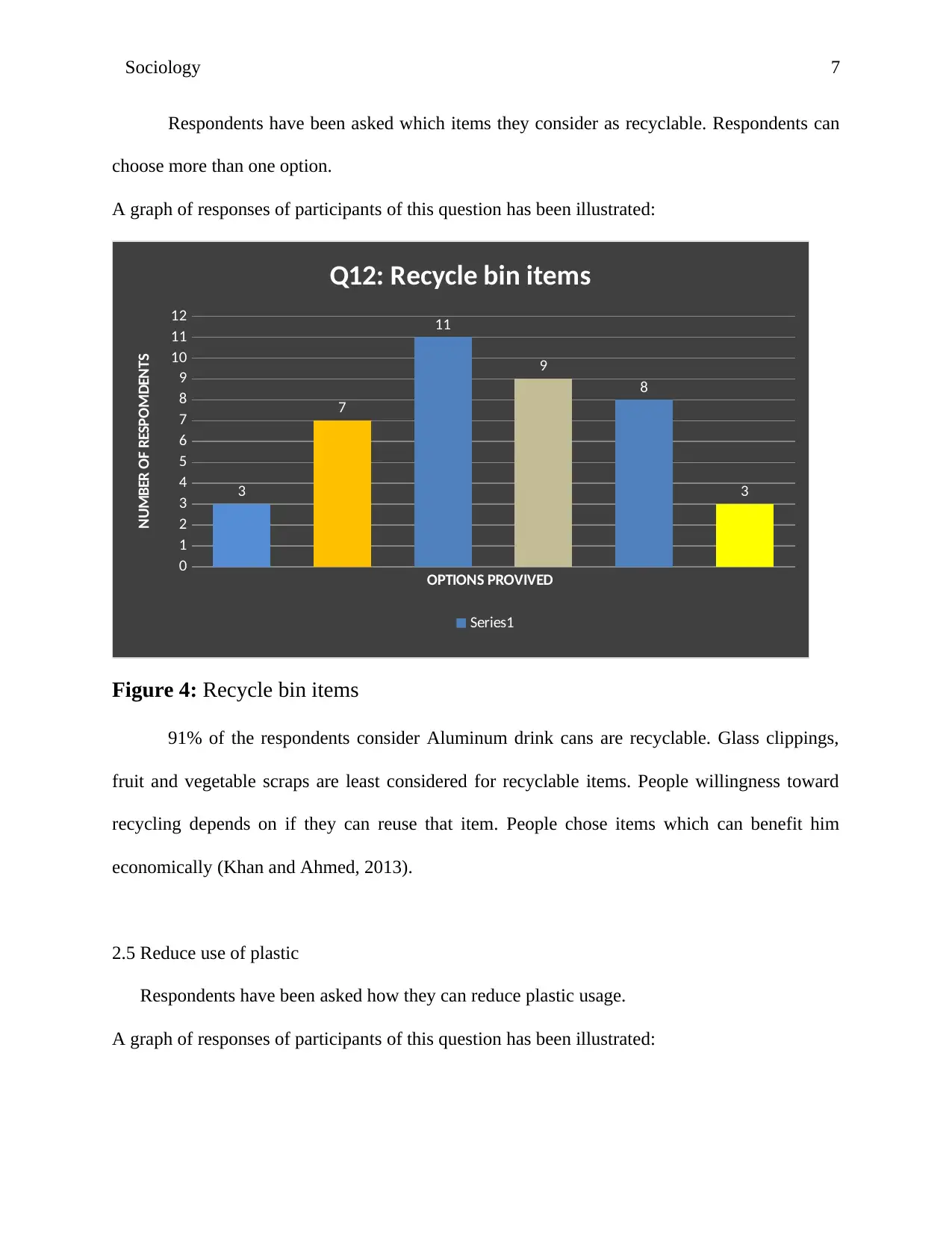
Sociology 7
Respondents have been asked which items they consider as recyclable. Respondents can
choose more than one option.
A graph of responses of participants of this question has been illustrated:
0
1
2
3
4
5
6
7
8
9
10
11
12
3
7
11
9
8
3
Q12: Recycle bin items
Series1
OPTIONS PROVIVED
NUMBER OF RESPOMDENTS
Figure 4: Recycle bin items
91% of the respondents consider Aluminum drink cans are recyclable. Glass clippings,
fruit and vegetable scraps are least considered for recyclable items. People willingness toward
recycling depends on if they can reuse that item. People chose items which can benefit him
economically (Khan and Ahmed, 2013).
2.5 Reduce use of plastic
Respondents have been asked how they can reduce plastic usage.
A graph of responses of participants of this question has been illustrated:
Respondents have been asked which items they consider as recyclable. Respondents can
choose more than one option.
A graph of responses of participants of this question has been illustrated:
0
1
2
3
4
5
6
7
8
9
10
11
12
3
7
11
9
8
3
Q12: Recycle bin items
Series1
OPTIONS PROVIVED
NUMBER OF RESPOMDENTS
Figure 4: Recycle bin items
91% of the respondents consider Aluminum drink cans are recyclable. Glass clippings,
fruit and vegetable scraps are least considered for recyclable items. People willingness toward
recycling depends on if they can reuse that item. People chose items which can benefit him
economically (Khan and Ahmed, 2013).
2.5 Reduce use of plastic
Respondents have been asked how they can reduce plastic usage.
A graph of responses of participants of this question has been illustrated:
Paraphrase This Document
Need a fresh take? Get an instant paraphrase of this document with our AI Paraphraser
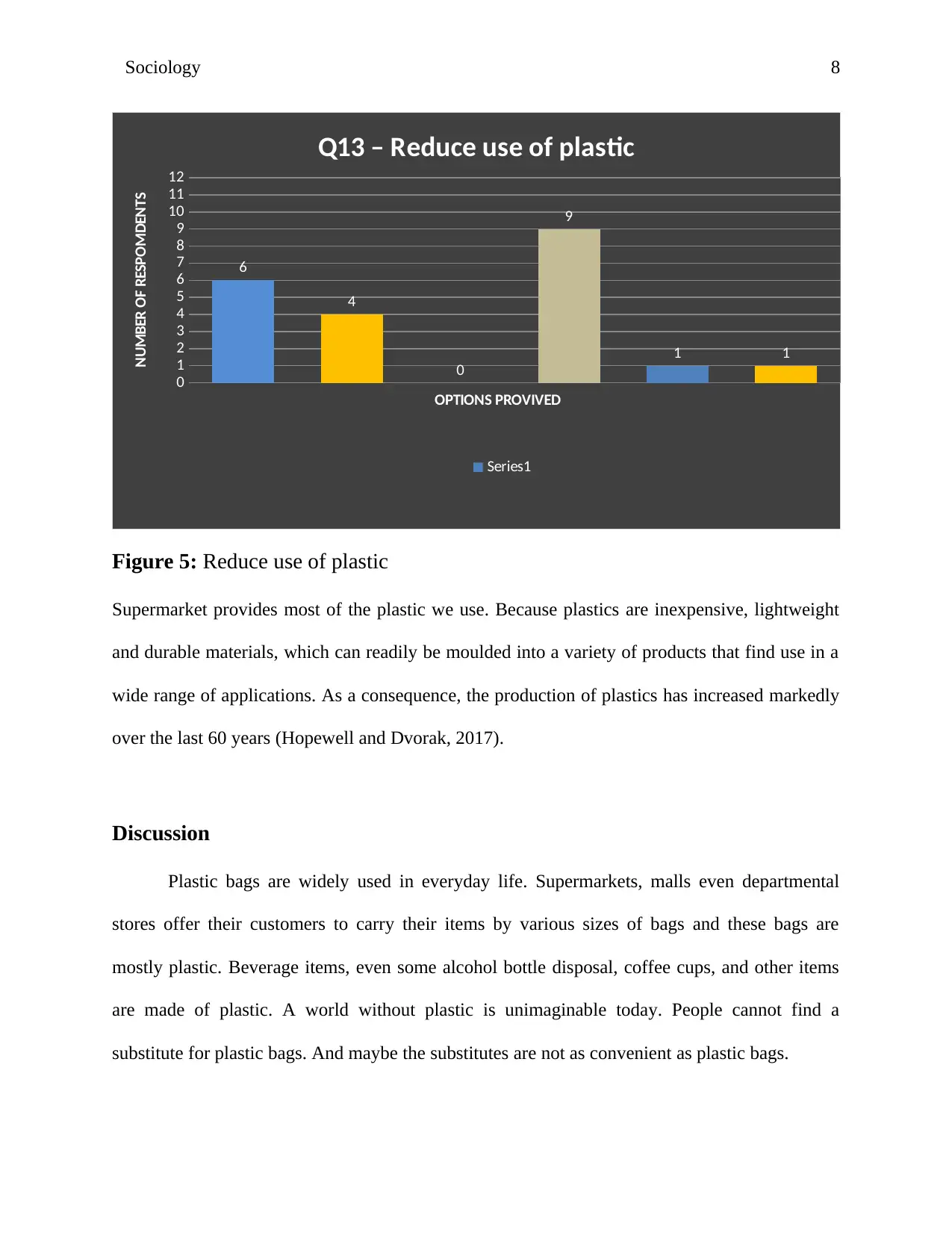
Sociology 8
0
1
2
3
4
5
6
7
8
9
10
11
12
6
4
0
9
1 1
Q13 – Reduce use of plastic
Series1
OPTIONS PROVIVED
NUMBER OF RESPOMDENTS
Figure 5: Reduce use of plastic
Supermarket provides most of the plastic we use. Because plastics are inexpensive, lightweight
and durable materials, which can readily be moulded into a variety of products that find use in a
wide range of applications. As a consequence, the production of plastics has increased markedly
over the last 60 years (Hopewell and Dvorak, 2017).
Discussion
Plastic bags are widely used in everyday life. Supermarkets, malls even departmental
stores offer their customers to carry their items by various sizes of bags and these bags are
mostly plastic. Beverage items, even some alcohol bottle disposal, coffee cups, and other items
are made of plastic. A world without plastic is unimaginable today. People cannot find a
substitute for plastic bags. And maybe the substitutes are not as convenient as plastic bags.
0
1
2
3
4
5
6
7
8
9
10
11
12
6
4
0
9
1 1
Q13 – Reduce use of plastic
Series1
OPTIONS PROVIVED
NUMBER OF RESPOMDENTS
Figure 5: Reduce use of plastic
Supermarket provides most of the plastic we use. Because plastics are inexpensive, lightweight
and durable materials, which can readily be moulded into a variety of products that find use in a
wide range of applications. As a consequence, the production of plastics has increased markedly
over the last 60 years (Hopewell and Dvorak, 2017).
Discussion
Plastic bags are widely used in everyday life. Supermarkets, malls even departmental
stores offer their customers to carry their items by various sizes of bags and these bags are
mostly plastic. Beverage items, even some alcohol bottle disposal, coffee cups, and other items
are made of plastic. A world without plastic is unimaginable today. People cannot find a
substitute for plastic bags. And maybe the substitutes are not as convenient as plastic bags.
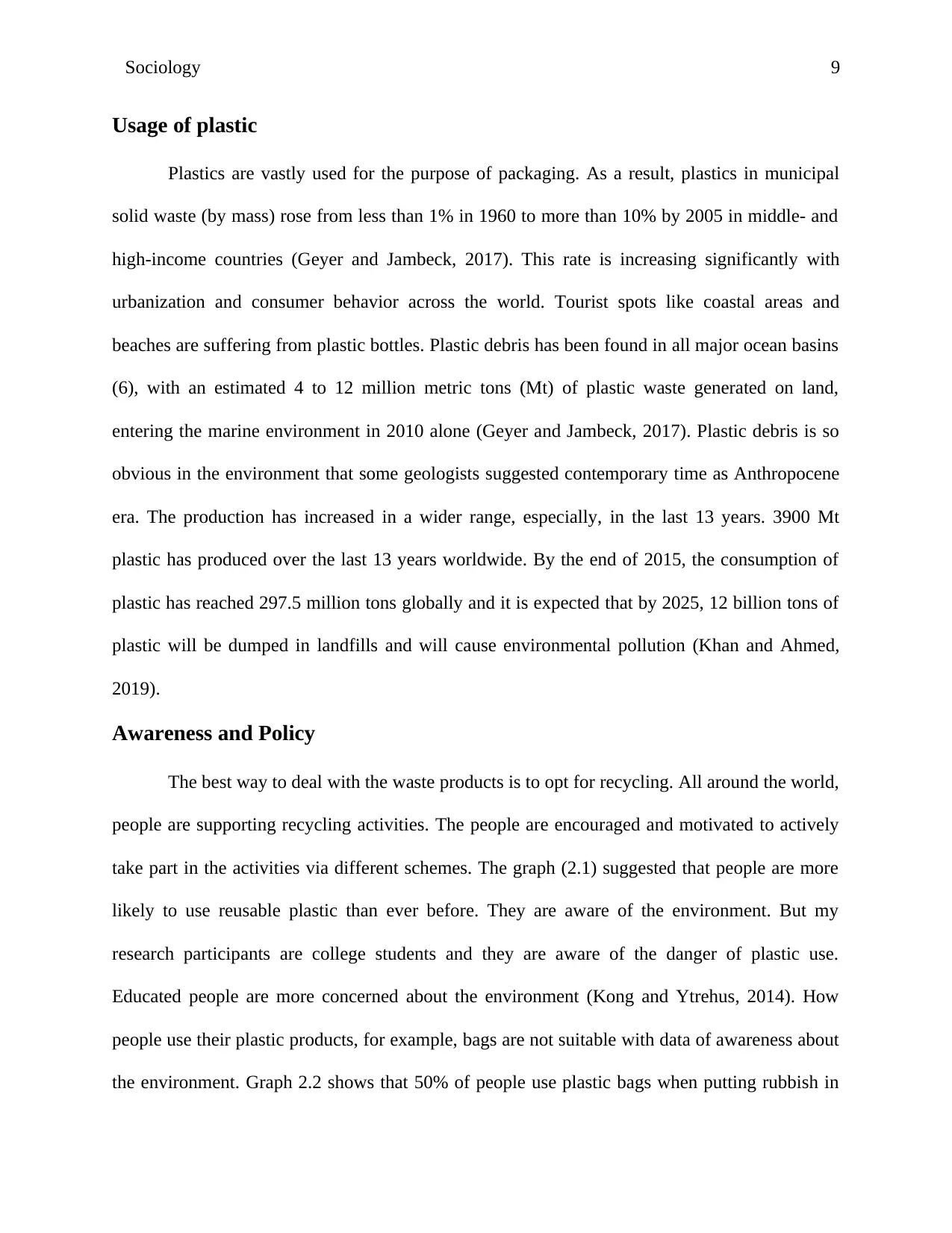
Sociology 9
Usage of plastic
Plastics are vastly used for the purpose of packaging. As a result, plastics in municipal
solid waste (by mass) rose from less than 1% in 1960 to more than 10% by 2005 in middle- and
high-income countries (Geyer and Jambeck, 2017). This rate is increasing significantly with
urbanization and consumer behavior across the world. Tourist spots like coastal areas and
beaches are suffering from plastic bottles. Plastic debris has been found in all major ocean basins
(6), with an estimated 4 to 12 million metric tons (Mt) of plastic waste generated on land,
entering the marine environment in 2010 alone (Geyer and Jambeck, 2017). Plastic debris is so
obvious in the environment that some geologists suggested contemporary time as Anthropocene
era. The production has increased in a wider range, especially, in the last 13 years. 3900 Mt
plastic has produced over the last 13 years worldwide. By the end of 2015, the consumption of
plastic has reached 297.5 million tons globally and it is expected that by 2025, 12 billion tons of
plastic will be dumped in landfills and will cause environmental pollution (Khan and Ahmed,
2019).
Awareness and Policy
The best way to deal with the waste products is to opt for recycling. All around the world,
people are supporting recycling activities. The people are encouraged and motivated to actively
take part in the activities via different schemes. The graph (2.1) suggested that people are more
likely to use reusable plastic than ever before. They are aware of the environment. But my
research participants are college students and they are aware of the danger of plastic use.
Educated people are more concerned about the environment (Kong and Ytrehus, 2014). How
people use their plastic products, for example, bags are not suitable with data of awareness about
the environment. Graph 2.2 shows that 50% of people use plastic bags when putting rubbish in
Usage of plastic
Plastics are vastly used for the purpose of packaging. As a result, plastics in municipal
solid waste (by mass) rose from less than 1% in 1960 to more than 10% by 2005 in middle- and
high-income countries (Geyer and Jambeck, 2017). This rate is increasing significantly with
urbanization and consumer behavior across the world. Tourist spots like coastal areas and
beaches are suffering from plastic bottles. Plastic debris has been found in all major ocean basins
(6), with an estimated 4 to 12 million metric tons (Mt) of plastic waste generated on land,
entering the marine environment in 2010 alone (Geyer and Jambeck, 2017). Plastic debris is so
obvious in the environment that some geologists suggested contemporary time as Anthropocene
era. The production has increased in a wider range, especially, in the last 13 years. 3900 Mt
plastic has produced over the last 13 years worldwide. By the end of 2015, the consumption of
plastic has reached 297.5 million tons globally and it is expected that by 2025, 12 billion tons of
plastic will be dumped in landfills and will cause environmental pollution (Khan and Ahmed,
2019).
Awareness and Policy
The best way to deal with the waste products is to opt for recycling. All around the world,
people are supporting recycling activities. The people are encouraged and motivated to actively
take part in the activities via different schemes. The graph (2.1) suggested that people are more
likely to use reusable plastic than ever before. They are aware of the environment. But my
research participants are college students and they are aware of the danger of plastic use.
Educated people are more concerned about the environment (Kong and Ytrehus, 2014). How
people use their plastic products, for example, bags are not suitable with data of awareness about
the environment. Graph 2.2 shows that 50% of people use plastic bags when putting rubbish in
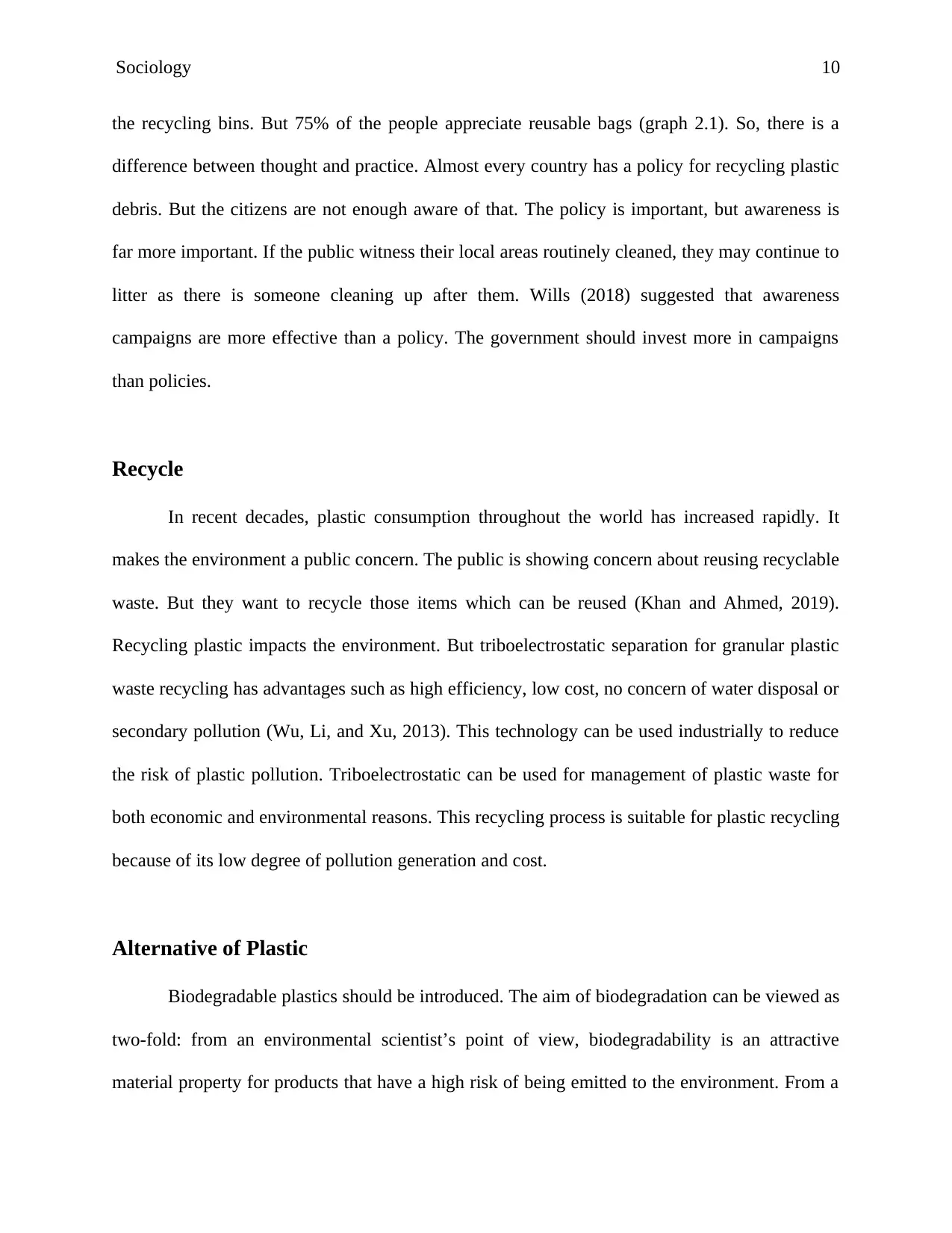
Sociology 10
the recycling bins. But 75% of the people appreciate reusable bags (graph 2.1). So, there is a
difference between thought and practice. Almost every country has a policy for recycling plastic
debris. But the citizens are not enough aware of that. The policy is important, but awareness is
far more important. If the public witness their local areas routinely cleaned, they may continue to
litter as there is someone cleaning up after them. Wills (2018) suggested that awareness
campaigns are more effective than a policy. The government should invest more in campaigns
than policies.
Recycle
In recent decades, plastic consumption throughout the world has increased rapidly. It
makes the environment a public concern. The public is showing concern about reusing recyclable
waste. But they want to recycle those items which can be reused (Khan and Ahmed, 2019).
Recycling plastic impacts the environment. But triboelectrostatic separation for granular plastic
waste recycling has advantages such as high efficiency, low cost, no concern of water disposal or
secondary pollution (Wu, Li, and Xu, 2013). This technology can be used industrially to reduce
the risk of plastic pollution. Triboelectrostatic can be used for management of plastic waste for
both economic and environmental reasons. This recycling process is suitable for plastic recycling
because of its low degree of pollution generation and cost.
Alternative of Plastic
Biodegradable plastics should be introduced. The aim of biodegradation can be viewed as
two-fold: from an environmental scientist’s point of view, biodegradability is an attractive
material property for products that have a high risk of being emitted to the environment. From a
the recycling bins. But 75% of the people appreciate reusable bags (graph 2.1). So, there is a
difference between thought and practice. Almost every country has a policy for recycling plastic
debris. But the citizens are not enough aware of that. The policy is important, but awareness is
far more important. If the public witness their local areas routinely cleaned, they may continue to
litter as there is someone cleaning up after them. Wills (2018) suggested that awareness
campaigns are more effective than a policy. The government should invest more in campaigns
than policies.
Recycle
In recent decades, plastic consumption throughout the world has increased rapidly. It
makes the environment a public concern. The public is showing concern about reusing recyclable
waste. But they want to recycle those items which can be reused (Khan and Ahmed, 2019).
Recycling plastic impacts the environment. But triboelectrostatic separation for granular plastic
waste recycling has advantages such as high efficiency, low cost, no concern of water disposal or
secondary pollution (Wu, Li, and Xu, 2013). This technology can be used industrially to reduce
the risk of plastic pollution. Triboelectrostatic can be used for management of plastic waste for
both economic and environmental reasons. This recycling process is suitable for plastic recycling
because of its low degree of pollution generation and cost.
Alternative of Plastic
Biodegradable plastics should be introduced. The aim of biodegradation can be viewed as
two-fold: from an environmental scientist’s point of view, biodegradability is an attractive
material property for products that have a high risk of being emitted to the environment. From a
Secure Best Marks with AI Grader
Need help grading? Try our AI Grader for instant feedback on your assignments.
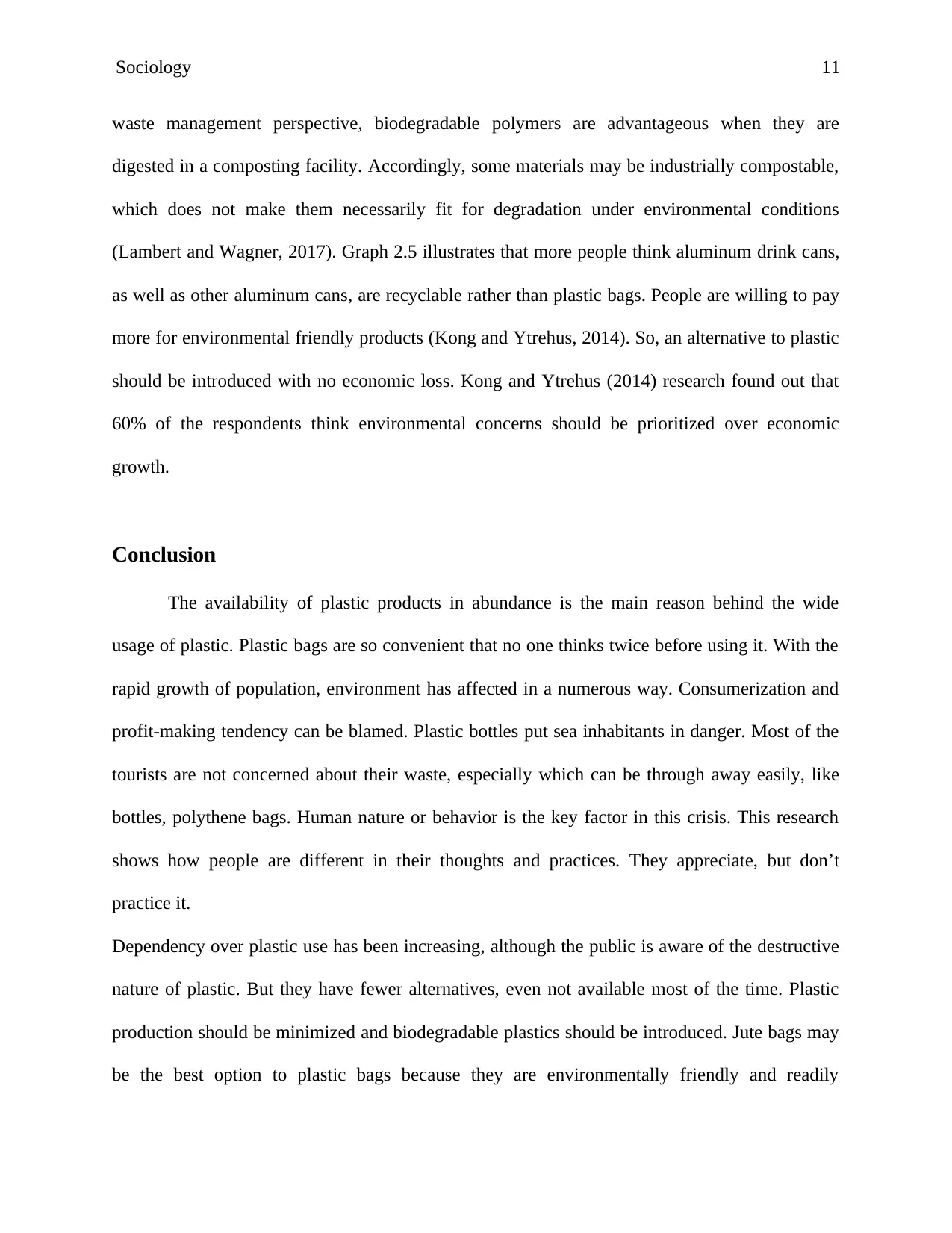
Sociology 11
waste management perspective, biodegradable polymers are advantageous when they are
digested in a composting facility. Accordingly, some materials may be industrially compostable,
which does not make them necessarily fit for degradation under environmental conditions
(Lambert and Wagner, 2017). Graph 2.5 illustrates that more people think aluminum drink cans,
as well as other aluminum cans, are recyclable rather than plastic bags. People are willing to pay
more for environmental friendly products (Kong and Ytrehus, 2014). So, an alternative to plastic
should be introduced with no economic loss. Kong and Ytrehus (2014) research found out that
60% of the respondents think environmental concerns should be prioritized over economic
growth.
Conclusion
The availability of plastic products in abundance is the main reason behind the wide
usage of plastic. Plastic bags are so convenient that no one thinks twice before using it. With the
rapid growth of population, environment has affected in a numerous way. Consumerization and
profit-making tendency can be blamed. Plastic bottles put sea inhabitants in danger. Most of the
tourists are not concerned about their waste, especially which can be through away easily, like
bottles, polythene bags. Human nature or behavior is the key factor in this crisis. This research
shows how people are different in their thoughts and practices. They appreciate, but don’t
practice it.
Dependency over plastic use has been increasing, although the public is aware of the destructive
nature of plastic. But they have fewer alternatives, even not available most of the time. Plastic
production should be minimized and biodegradable plastics should be introduced. Jute bags may
be the best option to plastic bags because they are environmentally friendly and readily
waste management perspective, biodegradable polymers are advantageous when they are
digested in a composting facility. Accordingly, some materials may be industrially compostable,
which does not make them necessarily fit for degradation under environmental conditions
(Lambert and Wagner, 2017). Graph 2.5 illustrates that more people think aluminum drink cans,
as well as other aluminum cans, are recyclable rather than plastic bags. People are willing to pay
more for environmental friendly products (Kong and Ytrehus, 2014). So, an alternative to plastic
should be introduced with no economic loss. Kong and Ytrehus (2014) research found out that
60% of the respondents think environmental concerns should be prioritized over economic
growth.
Conclusion
The availability of plastic products in abundance is the main reason behind the wide
usage of plastic. Plastic bags are so convenient that no one thinks twice before using it. With the
rapid growth of population, environment has affected in a numerous way. Consumerization and
profit-making tendency can be blamed. Plastic bottles put sea inhabitants in danger. Most of the
tourists are not concerned about their waste, especially which can be through away easily, like
bottles, polythene bags. Human nature or behavior is the key factor in this crisis. This research
shows how people are different in their thoughts and practices. They appreciate, but don’t
practice it.
Dependency over plastic use has been increasing, although the public is aware of the destructive
nature of plastic. But they have fewer alternatives, even not available most of the time. Plastic
production should be minimized and biodegradable plastics should be introduced. Jute bags may
be the best option to plastic bags because they are environmentally friendly and readily
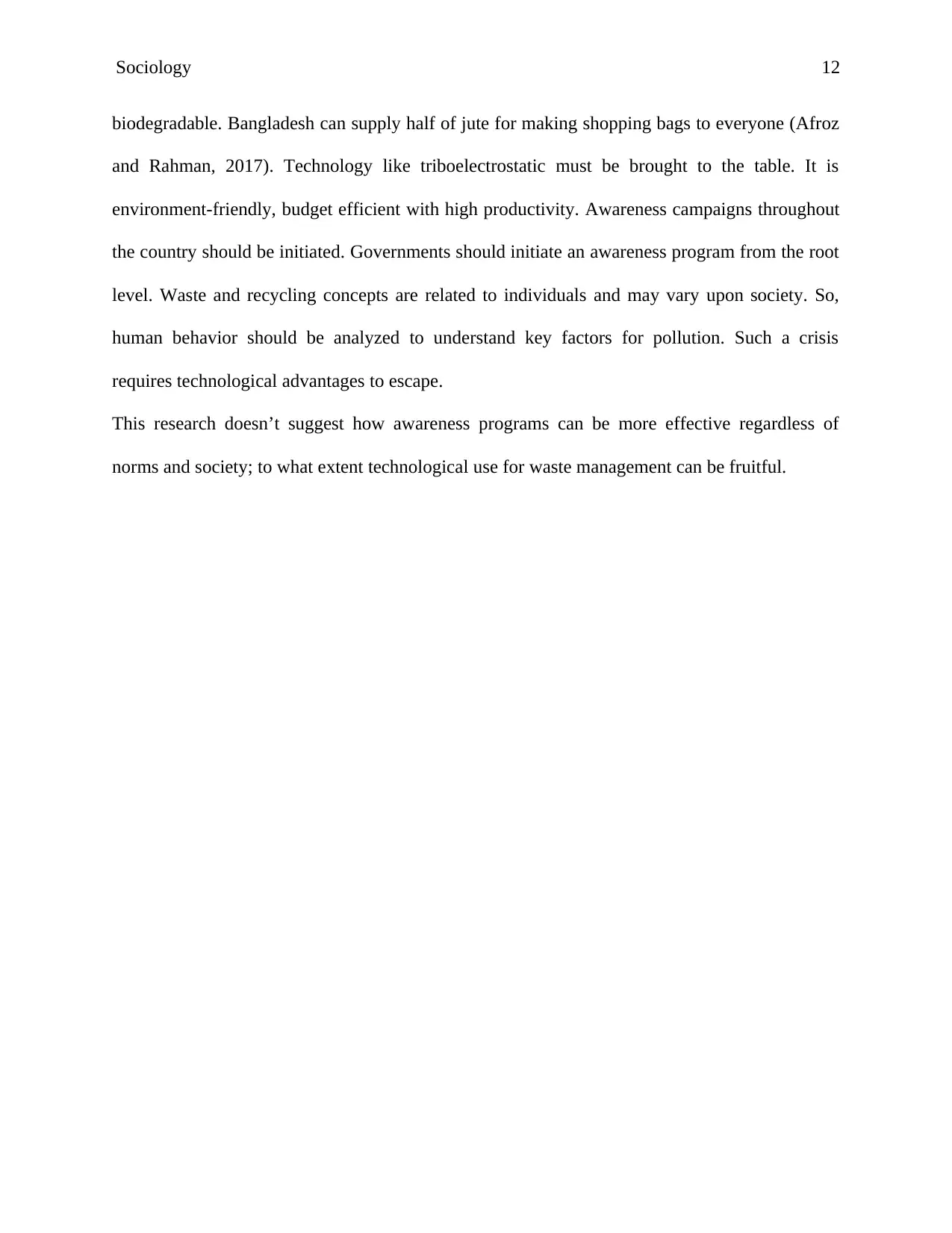
Sociology 12
biodegradable. Bangladesh can supply half of jute for making shopping bags to everyone (Afroz
and Rahman, 2017). Technology like triboelectrostatic must be brought to the table. It is
environment-friendly, budget efficient with high productivity. Awareness campaigns throughout
the country should be initiated. Governments should initiate an awareness program from the root
level. Waste and recycling concepts are related to individuals and may vary upon society. So,
human behavior should be analyzed to understand key factors for pollution. Such a crisis
requires technological advantages to escape.
This research doesn’t suggest how awareness programs can be more effective regardless of
norms and society; to what extent technological use for waste management can be fruitful.
biodegradable. Bangladesh can supply half of jute for making shopping bags to everyone (Afroz
and Rahman, 2017). Technology like triboelectrostatic must be brought to the table. It is
environment-friendly, budget efficient with high productivity. Awareness campaigns throughout
the country should be initiated. Governments should initiate an awareness program from the root
level. Waste and recycling concepts are related to individuals and may vary upon society. So,
human behavior should be analyzed to understand key factors for pollution. Such a crisis
requires technological advantages to escape.
This research doesn’t suggest how awareness programs can be more effective regardless of
norms and society; to what extent technological use for waste management can be fruitful.
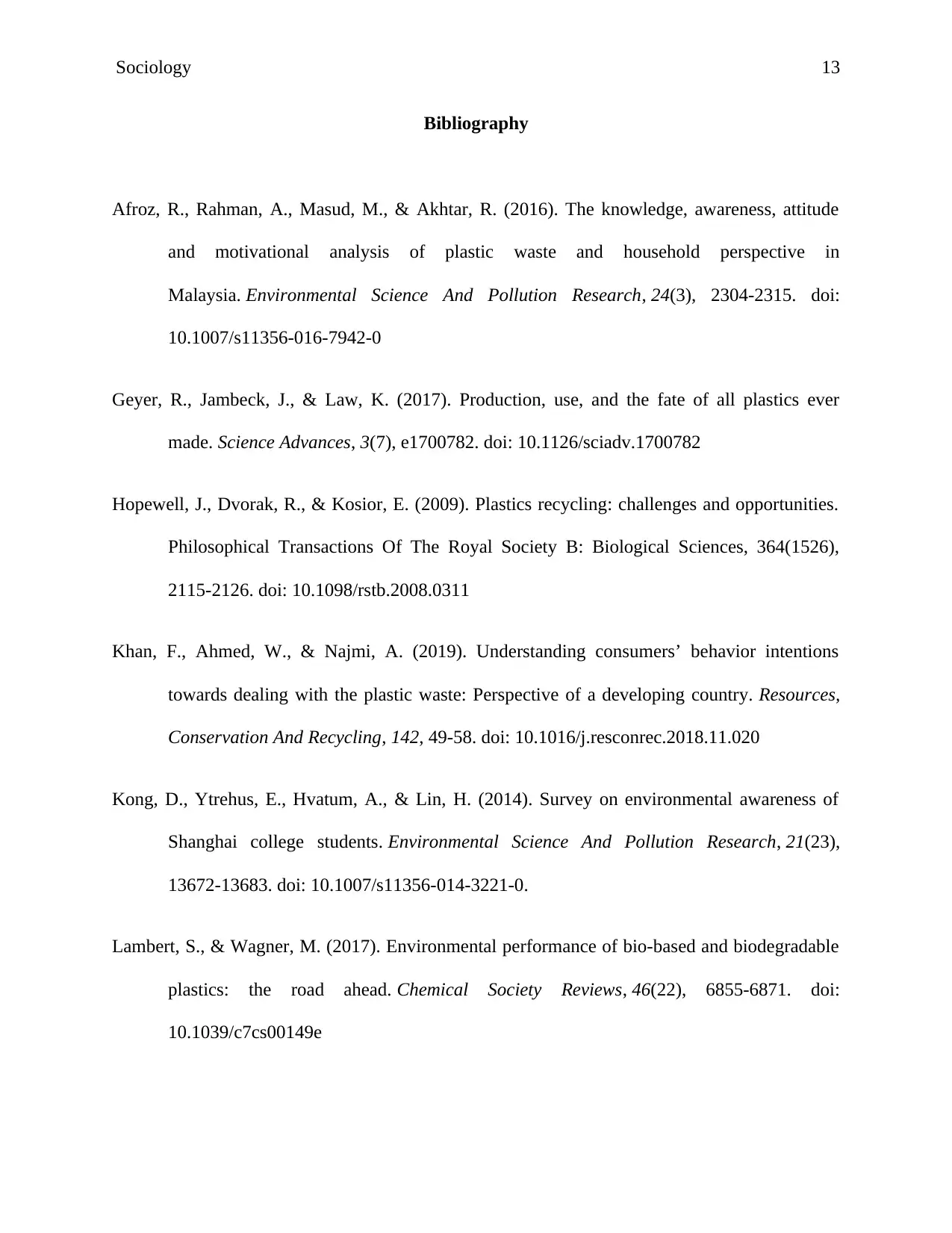
Sociology 13
Bibliography
Afroz, R., Rahman, A., Masud, M., & Akhtar, R. (2016). The knowledge, awareness, attitude
and motivational analysis of plastic waste and household perspective in
Malaysia. Environmental Science And Pollution Research, 24(3), 2304-2315. doi:
10.1007/s11356-016-7942-0
Geyer, R., Jambeck, J., & Law, K. (2017). Production, use, and the fate of all plastics ever
made. Science Advances, 3(7), e1700782. doi: 10.1126/sciadv.1700782
Hopewell, J., Dvorak, R., & Kosior, E. (2009). Plastics recycling: challenges and opportunities.
Philosophical Transactions Of The Royal Society B: Biological Sciences, 364(1526),
2115-2126. doi: 10.1098/rstb.2008.0311
Khan, F., Ahmed, W., & Najmi, A. (2019). Understanding consumers’ behavior intentions
towards dealing with the plastic waste: Perspective of a developing country. Resources,
Conservation And Recycling, 142, 49-58. doi: 10.1016/j.resconrec.2018.11.020
Kong, D., Ytrehus, E., Hvatum, A., & Lin, H. (2014). Survey on environmental awareness of
Shanghai college students. Environmental Science And Pollution Research, 21(23),
13672-13683. doi: 10.1007/s11356-014-3221-0.
Lambert, S., & Wagner, M. (2017). Environmental performance of bio-based and biodegradable
plastics: the road ahead. Chemical Society Reviews, 46(22), 6855-6871. doi:
10.1039/c7cs00149e
Bibliography
Afroz, R., Rahman, A., Masud, M., & Akhtar, R. (2016). The knowledge, awareness, attitude
and motivational analysis of plastic waste and household perspective in
Malaysia. Environmental Science And Pollution Research, 24(3), 2304-2315. doi:
10.1007/s11356-016-7942-0
Geyer, R., Jambeck, J., & Law, K. (2017). Production, use, and the fate of all plastics ever
made. Science Advances, 3(7), e1700782. doi: 10.1126/sciadv.1700782
Hopewell, J., Dvorak, R., & Kosior, E. (2009). Plastics recycling: challenges and opportunities.
Philosophical Transactions Of The Royal Society B: Biological Sciences, 364(1526),
2115-2126. doi: 10.1098/rstb.2008.0311
Khan, F., Ahmed, W., & Najmi, A. (2019). Understanding consumers’ behavior intentions
towards dealing with the plastic waste: Perspective of a developing country. Resources,
Conservation And Recycling, 142, 49-58. doi: 10.1016/j.resconrec.2018.11.020
Kong, D., Ytrehus, E., Hvatum, A., & Lin, H. (2014). Survey on environmental awareness of
Shanghai college students. Environmental Science And Pollution Research, 21(23),
13672-13683. doi: 10.1007/s11356-014-3221-0.
Lambert, S., & Wagner, M. (2017). Environmental performance of bio-based and biodegradable
plastics: the road ahead. Chemical Society Reviews, 46(22), 6855-6871. doi:
10.1039/c7cs00149e
Paraphrase This Document
Need a fresh take? Get an instant paraphrase of this document with our AI Paraphraser
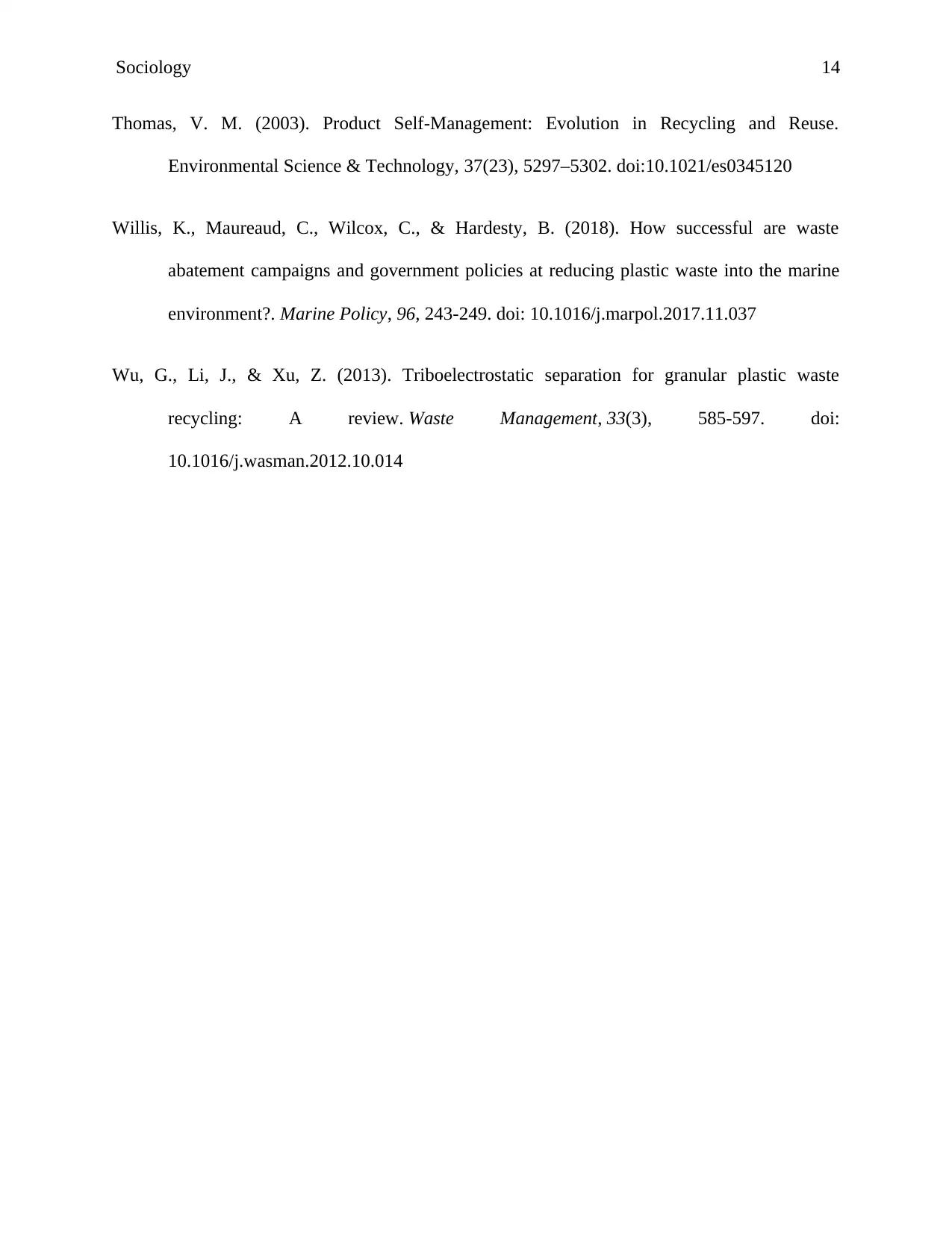
Sociology 14
Thomas, V. M. (2003). Product Self-Management: Evolution in Recycling and Reuse.
Environmental Science & Technology, 37(23), 5297–5302. doi:10.1021/es0345120
Willis, K., Maureaud, C., Wilcox, C., & Hardesty, B. (2018). How successful are waste
abatement campaigns and government policies at reducing plastic waste into the marine
environment?. Marine Policy, 96, 243-249. doi: 10.1016/j.marpol.2017.11.037
Wu, G., Li, J., & Xu, Z. (2013). Triboelectrostatic separation for granular plastic waste
recycling: A review. Waste Management, 33(3), 585-597. doi:
10.1016/j.wasman.2012.10.014
Thomas, V. M. (2003). Product Self-Management: Evolution in Recycling and Reuse.
Environmental Science & Technology, 37(23), 5297–5302. doi:10.1021/es0345120
Willis, K., Maureaud, C., Wilcox, C., & Hardesty, B. (2018). How successful are waste
abatement campaigns and government policies at reducing plastic waste into the marine
environment?. Marine Policy, 96, 243-249. doi: 10.1016/j.marpol.2017.11.037
Wu, G., Li, J., & Xu, Z. (2013). Triboelectrostatic separation for granular plastic waste
recycling: A review. Waste Management, 33(3), 585-597. doi:
10.1016/j.wasman.2012.10.014
1 out of 14
Your All-in-One AI-Powered Toolkit for Academic Success.
+13062052269
info@desklib.com
Available 24*7 on WhatsApp / Email
![[object Object]](/_next/static/media/star-bottom.7253800d.svg)
Unlock your academic potential
© 2024 | Zucol Services PVT LTD | All rights reserved.
